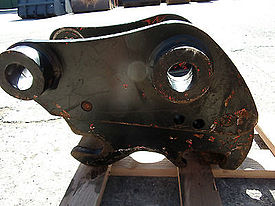 Also known as a quick hitch, a quick coupler is a heavy-duty industrial component that allows for the fast and efficient changing of buckets and attachments on industrial machines. Without a quick coupler, workers are required to manually drive out attachments, typically using a hammer. Once the attachment is removed, they can insert the mounting pin. A quick coupler, however, simplifies the process, making it an invaluable tool in the industrial workplace. To learn more about quick couplers and how they work, keep reading.
Also known as a quick hitch, a quick coupler is a heavy-duty industrial component that allows for the fast and efficient changing of buckets and attachments on industrial machines. Without a quick coupler, workers are required to manually drive out attachments, typically using a hammer. Once the attachment is removed, they can insert the mounting pin. A quick coupler, however, simplifies the process, making it an invaluable tool in the industrial workplace. To learn more about quick couplers and how they work, keep reading.
Quick Coupler Operation
In the most basic sense, a quick coupler is a component that’s installed on the end of industrial machines and heavy equipment. While it may offer other functions, its primary use is to allow for the rapid change of attachments and tools on the respective machine or equipment. Quick couplers are often used on hydraulic excavators, compact excavators, backhoe loaders, telescopic handlers, wheel loaders, skid-steer loaders, agricultural tractors and more.
Most quick couplers are installed using pins — the same pins that would be used for attachment mountings.
Different Types of Quick Couplers
Of course, there are several different types of quick couplers, each of which has own its unique characteristics. Generally speaking, quick couplers fall under the category of manual, semi-automatic or fully automatic, depending on its method of operation.
Manual quick couplers live up to their namesake by requiring the user to operate the quick coupler by hand. The user must walk to the end of the equipment or machinery and manually release the attachment. This must also be done in the correct order so that the next attachment will be used.
A semi-automatic quick coupler falls somewhere between a manual and fully automatic quick coupler. Like its manual counterpart, it’s used to operate the attachment mechanism of a machine or equipment, but it also requires the use of a safety device to ensure the attachment is secured in place with no “wiggle room.” The safety device is designed to prevent the attachment from releasing if failure occurs (e.g. loss of hydraulic pressure). Normally, the safety device is a pin that must be manually inserted into the quick coupler itself.
Finally, a third type of quick coupler is the fully automatic. It uses a hydraluc system to operate the attachment mechanism, and like the semi-automatic, it also features a safety mechanism. There’s no single best type of quick coupler, as each of the aforementioned types has its own strengths and weaknesses.
